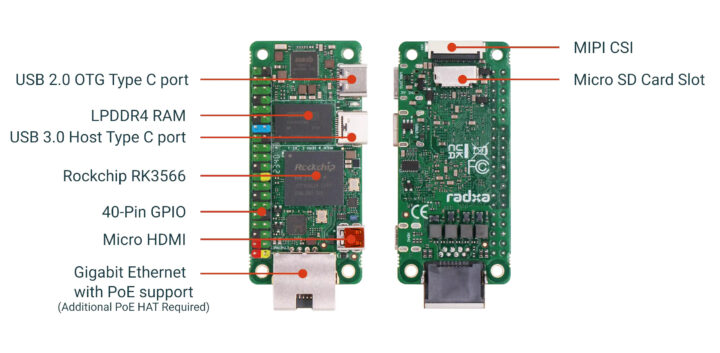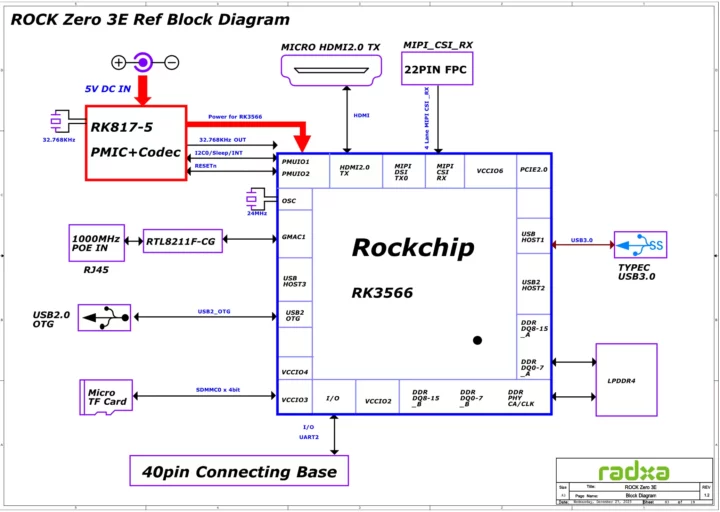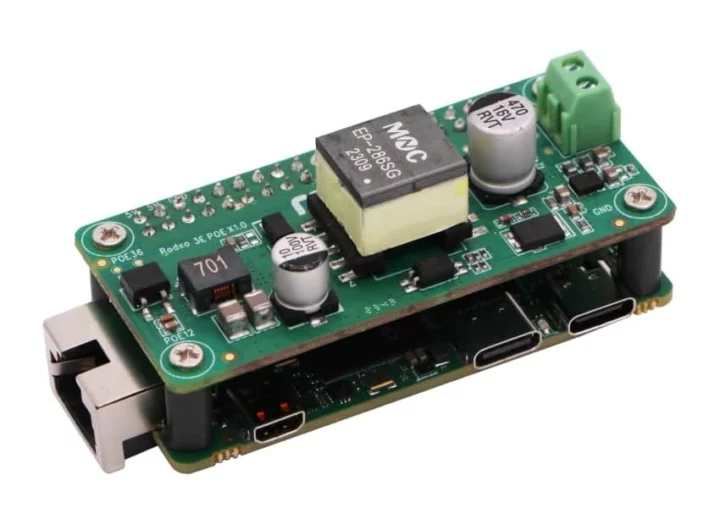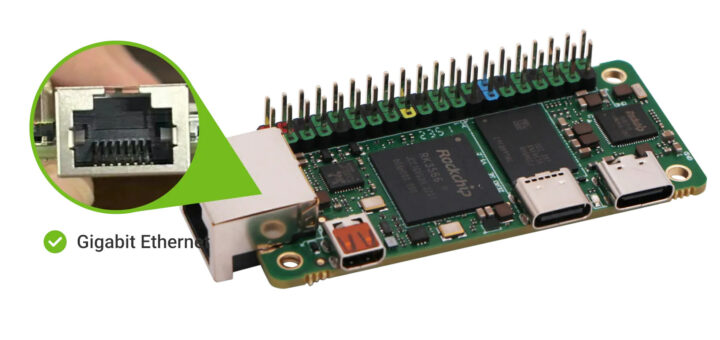Last December, we wrote about the Rockchip RK3566-powered Radxa Zero 3W WiFi 6 SBC and noted that the Radxa Zero 3E with gigabit Ethernet and optional PoE supports would be coming soon with about the same dimensions as the Raspberry Pi Zero 2 W. “Soon” is now as the Radxa Zero 3E is now available on Aliexpress or Amazon with RAM capacities from 1GB to 8GB LPDDR4.
The small SBC also comes with optional eMMC flash up to 64GB, a microSD card slot for storage, a micro HDMI video output port, a MIPI CSI connector compatible with Raspberry Pi Camera V1 and V2, two USB-C ports, and a 40-pin GPIO header for expansion.
Radxa Zero 3E specifications:
- SoC – Rockchip RK3566
- CPU – Quad-core Arm Cortex-A55 processor @ 1.6 GHz
- GPU – Arm Mali G52-2EE GPU with support for OpenGL ES 1.1/2.0/3.2, Vulkan 1.1, OpenCL 2.0
- NPU – 0.8 TOPS AI accelerator
- VPU – 4Kp60 H.265/H.264/VP9 video decoding, 1080p100f H.265/H.264 video encoding
- System Memory – 1GB, 2GB, 4GB, or 8GB LPDDR4
- Storage
Optional 8GB, 16GB, 32GB, or 64GB eMMC 5.1 flash(Note: flash module is only available on the Radxa Zero 3W board, not the 3E variant)
- MicroSD card slot (SDR104 capable)
- Video Output – Micro HDMI port up to 1080p60 (Not sure why 4Kp60 is not listed since the processor supports it)
- Camera – 4-lane MIPI CSI connector with support for Raspberry Pi Camera V1.3 (OV5647) and Raspberry Pi Camera V2 (IMX219).
- Networking – Gigabit Ethernet RJ45 port via RTL8211F-CG transceiver; optional PoE support through HAT expansion board
- USB – 1x USB 3.0 Type-C host port, 1x USB 2.0 Type-C OTG port
- Expansion – Optional 40-pin color-coded GPIO header with up to 28x GPIO, 5x UART, 1x SPI, 2x I2C, PCM/I2S, 6x PWM, 5V, 3.3V, and GND
- Misc – MaskROM button
- Power Supply
- 5V/2A (recommended) via USB-C OTG port
- Optional PoE support
- Dimensions – 65 x 30mm (72 x 30mm when taking the RJ45 jack into account)


Radxa officially supports an image with Debian 11 using XFCE desktop environment, but Ubuntu XFCE and Ubuntu CLI images are also available and “provided as-is except for critical issues”. You’ll find schematics, OS images, and other resources to get started on the documentation website.
Radxa just launched its Aliexpress store and the Radxa Zero 3E is in stock with either 2GB or 4GB RAM there for respectively $20.97 and $30.97 plus shipping, while the 1GB RAM version is in stock on Amazon for $16. Sadly the Radxa 3E PoE HAT is not sold on either platform, but you can still get it from Arace for $9.99, or wait a few more weeks…

Thanks to Willy for the reminder.

Jean-Luc started CNX Software in 2010 as a part-time endeavor, before quitting his job as a software engineering manager, and starting to write daily news, and reviews full time later in 2011.
Support CNX Software! Donate via cryptocurrencies, become a Patron on Patreon, or purchase goods on Amazon or Aliexpress






I really think that this is both the smallest and the cheapest gigabit-capable board to date. For VPN gateways as well as test probes, that’s really nice. It may even be used as a tiny USB NAS as used to exist 15 years ago with NSLU2 / Iomega Iconnect etc.
> I really think that this is both the smallest and the cheapest gigabit-capable board to date.
I may be wrong but IIRC the two Allwinner H5 based boards Orange Pi Zero Plus and NanoPi NEO2 were less expensive (and the latter also smaller if judging solely by board dimensions).
They *were* indeed but these no longer exist, and prices have significantly increased since then (almost doubled for entry level). The NEO2 was superseded by the NEO3 now at ~$23.
Can’t open AliExpress link
It still works for me. Do you mean the link won’t open at all, or the page will show product does not exist? It may depend on your country of residence.
Now it opens but it seems it can’t be sent to my country, Portugal
I cannot access it either from Denmark.
The link to the store is: https://www.aliexpress.com/store/1103615006
All I can see available for purchase is two cameras and a WiFi module. I have sent a message to the store directly through AliExpress to ask about opening up the store for EU customers.
EDIT: Got a response within a few minutes that they are currently addressing the issue and expect it to be resolved in the near future.
They just told me the following:
Hopefully, it’s a one-off thing and not for each product…
To implement PoE on such a small board is definitely innovate, we use the metal stands with plastic cover as “PoE header” to pass the power from the HAT to the 3E board.
Hi Tom! Not trying to dismiss your work at all, but regarding size, I think that GL.iNet’s PoE module for the AR150 was even smaller (not by much but it used to fit on a few vertical pins to solder directly on the board). Ah just found it: https://store.gl-inet.com/products/mini-poe-module so yes it does look slightly smaller indeed 😉
Ali-link from Netherlands, EU: “Sorry, the page you requested can not be found:(”
Again?!
And the Amazon-link is more clear: “This item cannot be shipped to your selected delivery location. Please choose a different delivery location.”
So: forbidden in EU? Not complying with security or VAT rules?
arace.tech is happily shipping to EU – 17 euros shipping for a 16 euros board
The design of the POE board is wrong because it does not expose the pin header.
They could make another batch with longer pins on the top of the POE to see if there is interest at least.
Here ismy EDK2 UEFI bootloader fork for the W version: https://github.com/extrowerk/quartz64_uefi/tree/radxa_zero_3w
This means i can run Fedora on this specific board? That would be awesome.
The shipping fee of 11.x$ for a 20$ board with 2GB RAM is a bit high, and with customs VAT fee i have to pay $40 delivered to me in Norway.
Which makes me hesitant to buy. Totalt cost of $25-30 i desirable.
Another question: how would i be able to update newer versions of Fedora?
Support for RHEL would also rock 🙂 If so the board with 8GB RAM would be more ideal for my use cases.
My 2 cents: if you don’t want to take the risk, then stay with x86-64 and do not jump on the sbc bandwagon.
Yeah, i’ve stayed away until this day. But i can see the use cases for such low power device for at least one or 2 projects.
Thanks!
I haven’t updated the README in the linked repo, so it represents the support status of the quartz64 board, not the Radxa Zero 3 one, but it might work more-or-less. Feel free to test it and report back.
I assumed so 🙂
Thanks again!